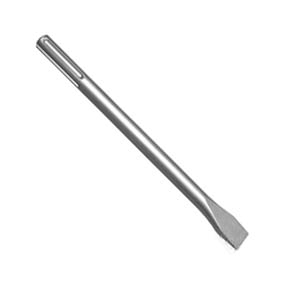
When it comes to wielding a demolition hammer for breaking through tough materials like concrete and masonry, the choice between scaling bits and chisel bits is crucial. Each type of bit is designed for specific tasks, and understanding their differences is essential for achieving optimal results. In this comprehensive guide, we'll delve into the characteristics of scaling bits and chisel bits, helping you decide which tool is best suited for your demolition needs.
Scaling Bits
Unleashing Precision for Surface Removal Design and Purpose: Scaling bits are flat, wide attachments designed for surface removal, cleaning, and scaling operations. They typically feature multiple horizontal or vertical blades that make contact with the material.
Applications
Ideal for removing old paint, rust, or coatings from surfaces. Effective in chipping away superficial layers of concrete or masonry. Suitable for surface preparation before applying new materials.
Benefits
Offers precision and control for tasks that require material removal without significant depth. Minimizes the risk of causing structural damage to the underlying surface.
Considerations
Scaling bits are not designed for heavy-duty demolition tasks involving significant material penetration. Chisel Bits: Penetrating Power for Deep
Demolition Design and Purpose
Chisel bits feature a pointed or flat, chisel-like tip designed for deep penetration into tough materials. They are capable of breaking through concrete, asphalt, and masonry with forceful impact.
Applications
Ideal for breaking through thick concrete slabs, walls, or foundations. Suitable for tasks requiring substantial material removal and demolition.
Benefits
Provides powerful impact for efficient and quick material penetration. Versatile for various demolition projects, especially those requiring significant depth.
Considerations
Chisel bits may lack the precision of scaling bits and can cause more substantial surface damage.
Choosing the Right Bit for the Job
Task Specificity: Assess the nature of your demolition task. If surface removal or cleaning is the primary goal, scaling bits are preferable. For deep penetration and heavy demolition, chisel bits are more suitable.
Material Characteristics
Consider the hardness and thickness of the material you are demolishing. Chisel bits are better for hard, thick materials, while scaling bits are effective for softer or thinner surfaces.
Precision vs. Power
If precision and control are paramount, such as when working on delicate surfaces or preparing for new materials, scaling bits are the better choice. For tasks requiring sheer power and force, chisel bits excel.
Project Scale
For smaller-scale projects or tasks where finesse is crucial, scaling bits may be more appropriate. Chisel bits are ideal for larger-scale demolitions.
Maintenance Tips
Keep Bits Sharp: Regularly inspect and sharpen the edges of both scaling and chisel bits to maintain their effectiveness.
Lubricate Moving Parts
Follow manufacturer recommendations for lubricating moving parts to ensure smooth operation.
Clean after Use
Clean bits after each use to remove dust and debris, preventing damage and maintaining performance.
Conclusion
In the scaling bits vs. chisel bits dilemma, the choice ultimately depends on the specific demands of your demolition project. Scaling bits offer precision and control for surface removal, while chisel bits deliver the power needed for deep penetration and heavy demolition. By understanding the applications, benefits, and considerations of each type of bit, you can confidently select the tool that best aligns with the requirements of your task. Remember to prioritize safety, wear the necessary protective gear, and follow manufacturer guidelines for the optimal and safe use of your chosen demolition bit.
Learn more about our products! SDS Plus Vs SDS Max | Demolition Bits Types and Their Uses | Carbide Whirley Bits: Revolutionizing Highway Expansion Projects
